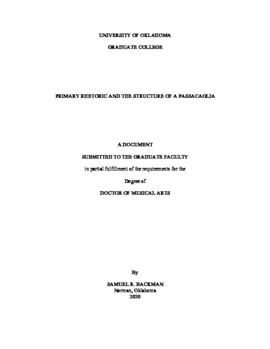| dc.description.abstract | The art of the musician is much like that of the orator. Both are charged with the delivery of a sonic medium over the unfolding course of time. Furthermore, both the orator and musician must be attentive to disposition of their audience if they are to communicate effectively. Since the genesis of the discipline of rhetoric in Sicily in 5th Century BC, the musician has been invoked as a model for the rhetorician. Over time, musical theorists and composers extoled the rhetorical methods of such figures as Cicero and Quintilian, regarding them as a model for creating music. This interest in rhetoric among musicians of the German Baroque culminated in a movement known as musica poetica. Simultaneous with the development of musica poetica was the emergence of a musical genre known as the passacaglia, which is a series of variations founded upon an ostinato in the bass. While this genre started out as an improvised folk tradition, it was quickly cultivated into a refined musical genre. Unlike many musical genres or forms, the passacaglia is not formally marked by contrasting sections such as a ritornello and episode. Rather, it is defined by the unwavering presence of a single melodic idea in a single key. As such, this genre holds the dangerous possibility of monotony. However, I argue that a skilled composer, equipped with a keen sense of proportion and the tools of oratory rhetoric, can produce a highly engaging composition in this genre. In applying the principles of rhetoric to music, it is important to distinguish between primary rhetoric, which concerns itself with the structure of a persuasive discourse, and secondary rhetoric, which is oriented toward small-scale poetic gestures or figures of speech. I argue that a fruitful application of rhetorical principles to music should be focused on primary rhetoric and that subsequent considerations of secondary rhetoric are of interest only insofar as they contribute to the broader narrative of primary rhetoric. Bach’s Passacaglia in C Minor, BWV 582, serves as an apt exemplar for musico-rhetorical analysis. In this document, I propose an analysis that divides the work into separate, composite sections that correspond to Quintilian’s five-part structure for an oration. | en_US |
